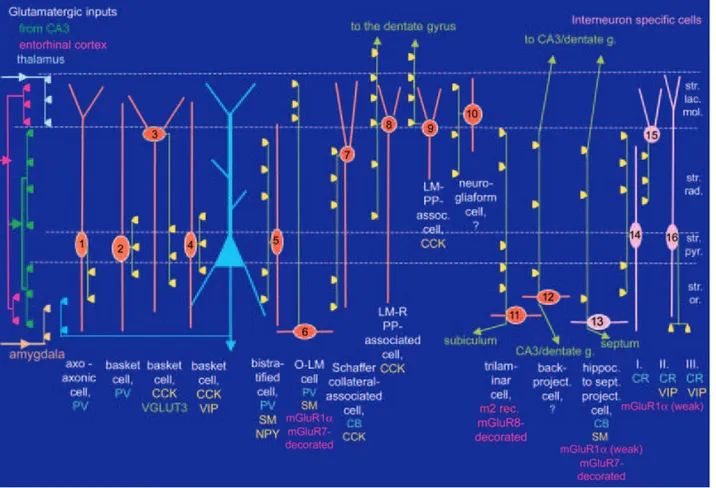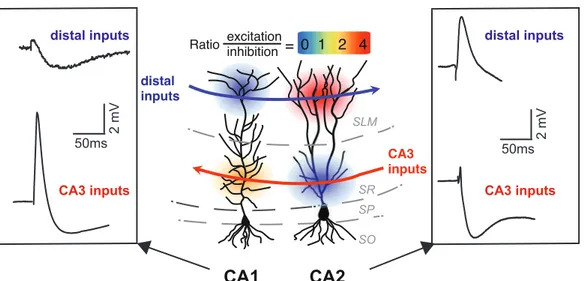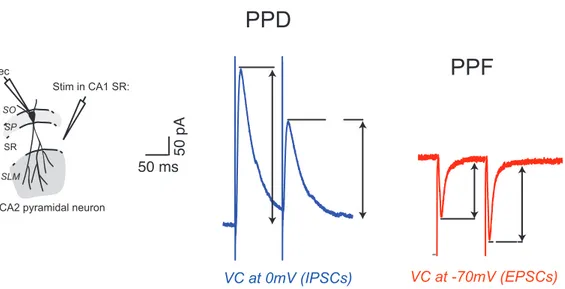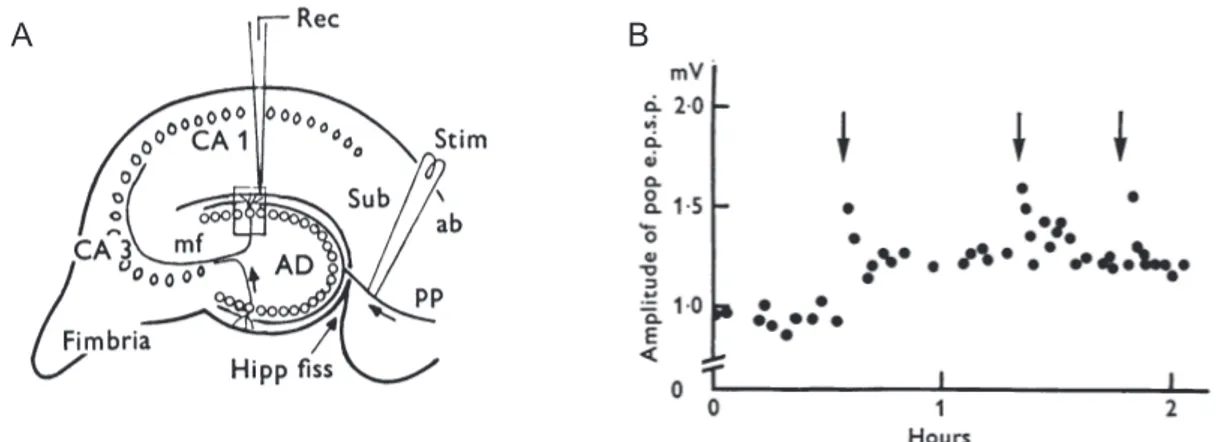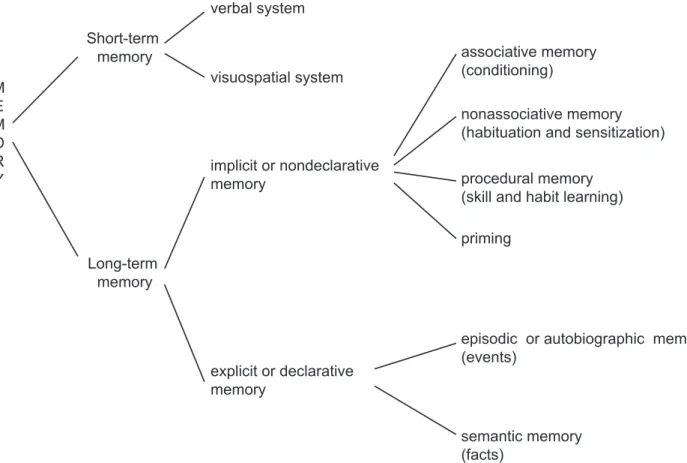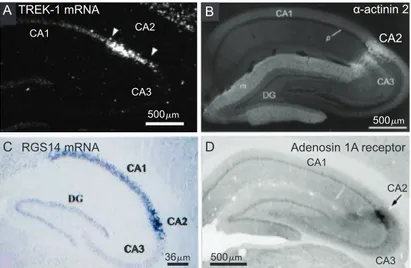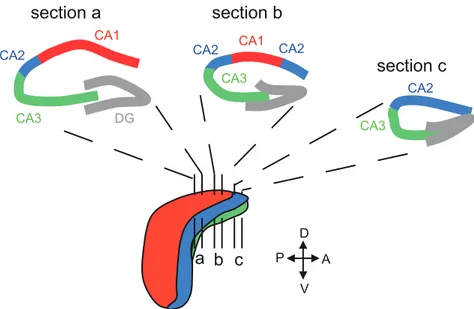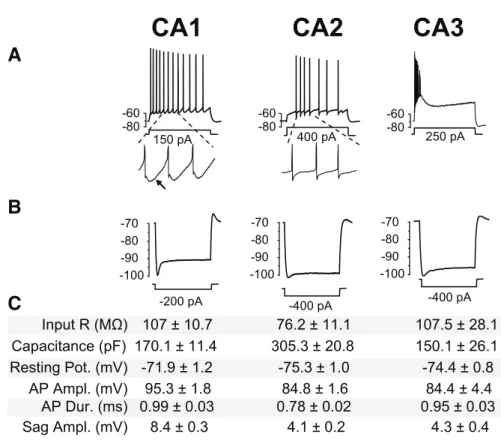HAL Id: tel-01535839
https://tel.archives-ouvertes.fr/tel-01535839
Submitted on 9 Jun 2017
HAL is a multi-disciplinary open access archive for the deposit and dissemination of sci-entific research documents, whether they are pub-lished or not. The documents may come from teaching and research institutions in France or abroad, or from public or private research centers.
L’archive ouverte pluridisciplinaire HAL, est destinée au dépôt et à la diffusion de documents scientifiques de niveau recherche, publiés ou non, émanant des établissements d’enseignement et de recherche français ou étrangers, des laboratoires publics ou privés.
synapses in mouse hippocampal area CA2 under normal
and pathological conditions
Kaoutsar Nasrallah
To cite this version:
Kaoutsar Nasrallah. Consequences of synaptic plasticity at inhibitory synapses in mouse hippocam-pal area CA2 under normal and pathological conditions. Human health and pathology. Université Sorbonne Paris Cité, 2015. English. �NNT : 2015USPCB089�. �tel-01535839�
!
!
!Université!Paris!Descartes!
Ecole&doctorale&Cerveau,&Cognition&et&Comportement&
Laboratoire)de)Physiologie)Cérébrale)UMR8118)/)Equipe)de)recherche)«)Plasticité)synaptique)et)réseaux) neuronaux)»)Consequences!of!synaptic!plasticity!at!inhibitory!synapses!
in!mouse!hippocampal!area!CA2!under!normal!and!
pathological!conditions!!
Par!Kaoutsar!Nasrallah!!
Doctorat!de!Neurosciences!
Dirigée par Vivien Chevaleyre, PhD
Présentée et soutenue publiquement le 23 Novembre 2015 Devant un jury composé de :
Pablo Castillo, PhD, MD (rapporteur) Dominique Massotte, DR (rapporteur) Manuel Mameli, CR (examinateur)
!
AKNOWLEDGEMENTS!
It!is!with!my!sincere!enthusiasm!that!I!thank!all!the!persons!who!contributed!to!the! realization!of!this!thesis:! I!thank!the!French!Ministère)de)la)Recherche!for!funding!my!work.! I!thank!Arthur!Huang!and!Thomas!McHugh!for!providing!the!CA2Jcre!mouse!line!and! DREADD!virus!and!Joseph!A.!Gogos!for!providing!the!Df(16)A+/J!mice.! I!thank!the!whole!laboratory!of!Isabel!Llano!for!their!warm!welcome!and!pleasant!work! atmosphere.!Thank!you!for!listening!to!me!during!the!progress!reports!and!giving!useful! advice.! In!particular,!I!thank!the!CA2!team!for!helpful!discussions!and!the!pleasant!working! environment.!I!thank!Vivien!Chevaleyre!and!Rebecca!Piskorowski!for!taking!me!on!as!a! student!in!their!team.!Thank!you!for!your!help!with!experiments,!for!teaching!me! electrophysiology!and!guiding!me.!All!of!the!expertise!that!I!have!gained!is!because!of!you.! Thank!you!for!your!availability,!your!patience,!your!advice,!your!daily!encouraging!attitude! and!the!desserts!that!fueled!me!during!this!thesis.!I!thank!Ludivine!Therreau!not!only!for!her! generous!help!with!stereotaxic!injections!and!immunostaining,!but!also!for!her!daily!good! mood!and!availability.!I!thank!Bob!(sorry!Vincent),!Sol!and!Assia!for!their!kindness,!humor,! support,!advice,!ACSF!preparation,!glass!pipettes!polished!and!coffee.! ! I!thank!my!thesis!committee!members,!Claire!Legay,!Dominique!Massotte,!Pablo!Castillo!and! Manuel!Mameli.!I!am!honored!to!have!you!evaluate!my!work.! ! I!thank!my!family:! I!thank!all!my!entourage!for!their!kindness,!entertainment,!tolerance,!thoughtfulness!and! confidence!in!me!and!my!abilities.! In!particular,!I!thank!my!mother!and!Dodo!who!have!always!supported!me,!put!up!with!me,! and!have!considerably!helped!me!to!complete!this!thesis.!I!thank!Soso!for!his! thoughtfulness.!I!thank!my!sisters!from!other!mothers,!Jeni!and!Loubz,!for!encouraging!me! and!helping!me.! I!thank!Ali!for!his!tolerance,!kindness,!confidence!in!me!and!motivation.!! ! ! ! ! ! ! ! !
I dedicate this work to my mother.
! ! ! ! ! ! ! ! ! ! !!
!
!
!
!
TABLE!OF!CONTENTS!
!
AKNOWLEDGEMENTS&...&2! LIST&OF&ABBREVIATIONS&...&6! LIST&OF&FIGURES&AND&TABLES&...&8! CHAPTER&I! INTRODUCTION&...&10! 1.! HIPPOCAMPUS!AND!MEMORY!...!10! 1.1! Hippocampal)neuroanatomy)...)10! 1.2! Hippocampal)neurophysiology)...)22! 1.3! A)spatial)and)mnemonic)role)of)the)hippocampus)...)33!2.! INCORPORATION!OF!THE!CA2!REGION!TO!HIPPOCAMPAL!FUNCTION!...!41!
2.1! Definition)and)properties)of)area)CA2)of)the)hippocampus)...)41! 2.2! Role)of)area)CA2)in)social)behavior,)memory)and)neuropathology)...)54! 3.! AIMS!OF!THE!THESIS!...!58! CHAPTER&II! MATERIALS&AND&METHODS&...&60! 1.! ANIMALS!...!60! 2.! STEREOTAXIC!VIRAL!INJECTIONS!AND!IMMUNOHISTOCHEMISTRY.!...!61! 3.! SLICE!PREPARATION:!...!62! 4.! ELECTROPHYSIOLOGICAL!RECORDINGS!AND!ANALYSIS.!...!63! CHAPTER&III! RESULTS&...&66! 1.! FIRST!STUDY:!INHIBITORY!PLASTICITY!PERMITS!THE!RECRUITMENT!OF!CA2!PYRAMIDAL!NEURONS!BY!CA3!(K! NASRALLAH,!R!PISKOROWSKI!AND!V!CHEVALEYRE,!2015).!...!66!
1.1! Introduction)...)66!
1.2! Paper)...)66!
2.! SECOND!STUDY:!“CONSEQUENCES!OF!INHIBITORY!LTD!IN!CA2!ON!THE!SYNAPTIC!DRIVE!OF!SC!INPUTS!ONTO! CA1!PYRAMIDAL!NEURONS”!(K!NASRALLAH,!R!PISKOROWSKI,!TJ!MCHUGH,!A!HUANG!AND!V!CHEVALEYRE,!2015,! IN!PREPARATION)!...!67!
2.1! Introduction:)...)67!
2.2! Results:)...)68!
3.! THIRD!STUDY:!AGEJDEPENDENT!SPECIFIC!CHANGE!IN!AREA!CA2!OF!THE!HIPPOCAMPUS!AND!SOCIAL!MEMORY! DEFICIT!IN!THE!22Q11.2!MOUSE!MODEL!OF!SCHIZOPHRENIA!(REBECCA!A.!PISKOROWSKI,!KAOUTSAR!NASRALLAH,! ANASTASIA!DIAMANTOPOULOU,!JUN!MUKAI,!STEVEN!A.!SIEGELBAUM,!JOSEPH!A.!GOGOS!AND!VIVIEN!CHEVALEYRE,! 2015)!...!82!
3.1! Introduction:)...)82!
3.2! Paper)...)82!
CHAPTER&IV! DISCUSSION&AND&FUTURE&DIRECTIONS&...&83! 1.! PHYSIOLOGICAL!AND!PATHOLOGICAL!CONSEQUENCES!OF!THE!DISINHIBITORY!ACTION!OF!DORS!IN!CA2!...!85!
1.1! Consequence)of)DORJmediated)iLTD)on)CA2)excitatory)inputs:)...)85!
1.2! Consequences)of)the)DORJmediated)iLTD)on)hippocampal)network)...)90!
2.! DIFFERENT!ROLE!OF!PVIS!IN!THE!TWO!HIPPOCAMPAL!ADJACENT!AREAS:!CA2!AND!CA1:!...!95!
2.2! Synaptic)plasticity)of)PVI)inhibitory)transmission)is)particular)in)area)CA2.)...)99! 2.3! AgeJdependent)loss)of)PVI)in)Df(16)A+/J)mice:)significance,)consequences)and)potential) causes)...)101! 3.! FUTURE!DIRECTIONS:!...!107! 3.1! Who)release)the)enkephalins?)...)107! 3.2! Consequence)of)DORJmediated)iLTD)on)the)LTP)at)SLMJCA2)synapses?)...)114! 3.3! Does)a)DORJindependent)iLTD)exist)in)area)CA2?)...)114! 3.4! How)to)rescue)the)social)memory)deficits)in)Df(16)A+/J)mice?)...)118! CHAPTER&V! CONCLUSION&...&119! CHAPTER&VI! REFERENCES&...&120! ! ! ! ! ! ! ! ! ! ! ! ! ! ! ! ! ! ! !
LIST!OF!ABBREVIATIONS!
aJtheta:!attentionJtheta!! DG:!dentate!gyrus! CA1,!CA2,!CA3:!Cornu)Ammonis!1,!Cornu)Ammonis!2,!Cornu)Ammonis!3! CaMKII:!Ca2+/calmodulinJdependent!protein!kinase!II! CB1:!cannabinoid!receptors!1! CCK:!cholecystokinin! DSI:!Depolarization!induced!Suppression!of!Inhibition! DG:!dentate!gyrus! EC:!entorhinal!cortex! EEG:!electroencephalogram! FBI:!feedback!inhibition! FFI:!feedforward!inhibition! GABA:!gammaJaminobutyric!acid! GIRK:!G!proteinJactivated!inwardly!rectifying!K+! Ih:!hyperpolarizationJactivated!cation!current! IPSC:!inhibitory!postJsynaptic!current! EC(II):!layer!2!of!the!EC! LIA:!large!irregular!amplitude!activity! LTM:!longJterm!memory! LTD:!longJterm!depression! LTP:!longJterm!potentiation! MF:!mossy!fibers! mGluR:!metabotropic!glutamate!receptor! NMDA:!NJmethylJDJaspartic!acid! NPY:!neuropeptide!Y!OJLM:!oriensJ)lacunosumJmoleculare! PN:!pyramidal!neuron! PP:!perforant!path! PPD:!pairJpulse!depression! PPF:!pairJpulse!facilitation! PTP:!postJtetanic!potentiation! PV:!parvalbumin! PV+:!parvalbuminJpositive!! PVI:!parvalbuminJexpressing!interneuron! REM:!rapid!eye!movement! SIA:!small!irregular!amplitude!activity! SC:!Schaffer!collateral! SL:!stratum)lucidum! SLM:!stratum)lacunosumJmoleculare! SO:)stratum)oriens) SOM:!somatostatin! SP:!stratum)pyramidale) SR:!stratum)radiatum) STM:)shortJterm!memory! SuM:!supramammillary!nucleus) SWRs:!sharpe!wave!ripples! TeNT:!tetanus!neurotoxin! tJtheta:!translationalJtheta! VIP:!vasoactive!intestinal!polypeptide! ! ! !
LIST!OF!FIGURES!AND!TABLES!
Figure I.1: The different hippocampal subfields in a transversale hippocampal slice.!...!10!
Figure I.2: Interneuron diversity.!...!13!
Figure I.3: The different cortico-hippocampal excitatory circuits.!...!17!
Figure I.4: Driving strength of CA3 and distal inputs onto CA1 and CA2 pyramidal neurons.!19! Figure I.5: Local inhibitory circuit.!...!20!
Figure I.6: Paired-pulse depression (PPD) and Paired-pulse facilitation (PPF) with 100ms inter-pulses interval.!...!27!
Figure I.7: Long-lasting potentiation after application of 100Hz tetanus.!...!28!
Figure I.8: Classification of the different forms of memory.!...!34!
Figure I.9: Region-specific genes in the hippocampus by in situ hybridization.!...!42!
Figure I.10: Examples of CA2-enriched molecules.!...!43!
Figure I.11: The hippocampal subfields along the transverse axis of the dorsal hippocampus. !...!44!
Figure I.12: Distinct electrophysiological properties of pyramidal neurons in the CA1, CA2 and CA3 hippocampal subfields.!...!48!
Figure I.13 : Lack of long-term potentiation at the CA3-CA2 excitatory synapse.!...!50!
Figure I.14: Properties of IPSPs Elicited by single presynaptic Action Potentials in Basket Cell–Pyramid Connections Recorded in the CA2 Region.!...!51!
Figure I.15: Inhibitory inputs onto CA2 PNs express a DOR-mediated LTD.!...!53!
Figure I.16: Inactivation of CA2 pyramidal neurons impairs social memory.!...!57!
! Figure II.1: Expression of the cre recombinase in CA2-cre mouse hippocampal slice.!...!60!
! Figure III.1: Pharmacogenetic silencing of PVIs largely reduces sIPSC frequency and the FFI evoked by the SC stimulation in CA2 but not in CA1 PNs.!...!76!
Figure III.2: In CA2, silencing PVIs increases both the PSP amplitude and the population spike (PS) magnitude evoked by SC stimulation.!...!77!
Figure III.3: Silencing PVIs occludes both the HFS- and the DPDPE-induced increase in amplitude of the PSP evoked by SC stimulation in CA2!...!78!
Figure III.4: DOR activation induces a long lasting increase of the SC net synaptic drive onto CA1 mediated by CA2.!...!79!
Figure III.5: CA2 PNs activity is required for the DOR-mediated increase of the SC synaptic drive onto CA1 PNs.!...!80!
!Figure III.6: Recruitment of CA2 PNs after induction of the DOR mediated iLTD increases CA1 neuron firing in response to SC stimulation.!...!81! !
Figure IV.1: Consequences of the DOR-mediated iLTD occurring in area CA2 on
hippocampal network.!...!93!
Figure IV. 2: HFS in SLM increases both SC proximal and distal excitatory drive onto CA2 PNs in GABA- and DOR-dependent manner. 110
Figure IV. 3: HFS in SLM induces a long-term increase of the amplitude of the PSPs evoked by both proximal and distal inputs in CA2 PNs via a disinhibition mechanism.. ... 111 Figure IV. 4: HFS in SLM allows CA3 inputs to evoke action potential firing in CA2 neurons.
... 112 Figure IV. 5: HFS induces a long-term increase of the PSP amplitude in CA2 via a
disinhibition mechanism. ... 116
))
)
)
)
)
)
)
)
)
!Chapter!I !!!!!!!!!!!INTRODUCTION!
1. Hippocampus&and&memory&&
1.1 Hippocampal&neuroanatomy&1.1.1 Different!types!of!neurons!in!the!hippocampus!!!
The!hippocampal!formation!is!a!brain!region!critical!for!spatial!navigation,)learning!and! memory! (Squire,! 1992).! It! consists! of! three! parts:! the! hippocampus! proper,! the! dentate! gyrus! (DG)! and! the! subiculum.! Closely! related! to! the! DG,! the! hippocampus! is! a! cortical! structure!of!the!medial!temporal!lobe!that!is!symmetrically!present!in!both!hemispheres!of! mammalians! brains.! Based! on! cytoarchitecture,! connectivity,! physiological! properties! and! genes!expression!profile,!it!is!further!subdivided!into!three!subfields!(Lorente!de!No,!1934;! Kjonigsen! et! al.,! 2011;! Lein! et! al.,! 2005;! Woodhams! et! al.,! 1993;! Zhao! et! al.,! 2001):! Cornu)
Ammonis!1!(CA1),!Cornu)Ammonis!2!(CA2)!and!Cornu)Ammonis!3!(CA3;!Figure!I.1).!
!
Figure I.1: The different hippocampal subfields in a transversale hippocampal slice. Drawing of Golgi-Cox stain illustrating the cytoarchitectural differences between the principal neurons in area CA1, CA2, CA3, the DG and the subiculum. Adapted from Ramon y Cajal, Histologie du System Nerveux de l'Homme et des Vertébrées ,1911.
& CA1 CA2 CA3 Dentate Gyrus Subiculum
Hippocampal!neurons!are!divided!into!two!major!populations!of!cells:!the!pyramidal! and! the! nonJpyramidal! neurons.! The! pyramidal! neurons! (PNs)! are! the! principal! neurons! in! hippocampus! and! they! cover! almost! 90%! of! total! hippocampal! neurons! (Traub! and! Miles,! 1991).! They! are! oriented! in! a! particular! way! that! gives! rise! to! the! remarkable! laminar! structure!of!the!hippocampus!(Figure!I.1).!Their!cell!bodies!are!arranged!in!sharply!defined! layer!of!three!to!six!cells!deep:!the!pyramidal!cell!layer!also!called!stratum)pyramidale)(SP).! Dendritic! trees! extend! from! both! apical! and! basal! sides! of! the! pyramids! cell! bodies,! perpendicularly! to! SP.! The! basal! dendrites! of! the! principal! neurons! are! located! in! the!
stratum) oriens) (SO),! the! next! layer! deep! to! SP.! Longer! than! the! basal! dendrites,! the! apical!
dendrites! extend! from! the! apex! of! PN! cell! body! and! traverse! successively! the! stratum)
lucidum! (SL),! the! stratum) radiatum! (SR)! and! the! stratum) lacunosumJmoleculare! (SLM)!
toward!the!DG!(Figure!I.1).!SL,!only!present!in!the!CA3!region,!contains!the!DG!granule!cell! axons! called! the! mossy! fibers! (MF)! which! make! synapse! onto! the! CA3! PNs! thorny! excrescences.!The!thorny!excrescences!are!complex!branched!spines!connected!by!a!single! mossy!fiber!bouton!(Hamlyn,!1962),!which!are!located!on!the!proximal!dendrites!of!CA3!PNs.! In!CA1,!it!has!been!reported!that!a!population!of!pyramidal!cells!is!located!in!SR!(Gulyás!et! al.,!1998;!Maccaferri!and!McBain,!1996),!or!at!the!border!with!SLM.!In!contrast!to!the!CA1! PNs!located!in!SP,!these!cells!project!uniquely!to!the!accessory!olfactory!bulb!(van!Groen!and! Wyss,! 1990)! and! they! may! have! local! axon! collaterals! also! within! SR,! in! addition! to! SO.! Besides! for! this! population! of! cells,! somatas! of! PNs! are! located! in! SP! while! cell! bodies! of! interneurons!are!present!in!SP,!but!also!in!the!other!strata!of!the!hippocampus.!
In!contrast!to!the!relative!uniformity!of!hippocampal!PNs,!high!level!of!heterogeneity! characterizes! interneurons.! Interneurons! represent! one! of! the! most! diverse! populations! in! the! mammalian! brain! in! terms! of& morphology,! connectivity! and! physiological! properties!
(Ascoli! et! al.,! 2009).! For! instance,! there! are! at! least! 16! classes! of! interneuron! in! the! hippocampal! CA1! area! (Somogyi! and! Klausberger,! 2005)! (Figure! I.2)! against! three! types! of! pyramidal!cell!in!the!whole!hippocampus.!Because!of!the!lack!of!a!better!unifying!criterion,! interneurons!could!be!defined!as!«!nonJpyramidal!neurons!»!in!the!hippocampus.!They!have! traditionally! been! considered! as! inhibitory! neurons! with! short! axons! that! exert! a! local! control! of! excitability.! However,! this! definition! presents! some! limits.! First,! it! have! been! described! that! there! exist! long! axonal! projections! from! interneurons! to! extraJhippocampal! areas!(Freund!and!Buzsáki,!1996).!For!instance,!the!hippocampoJseptal!cells,!which!express! somatostatin!(SOM)!(Jinno!and!Kosaka,!2002;!Zappone!and!Sloviter,!2001),!target!the!medial! septum!(Alonso!and!Köhler,!1982).!Furthermore,!the!subiculum!and!the!retrosplenial!cortex,! have! also! been! demonstrated! to! receive! longJrange! interneurons! projection! from! the! hippocampus!(Jinno!and!Kosaka,!2002;!Losonczy!et!al.,!2002;!Miyashita!and!Rockland,!2007;! Van!Groen!and!Wyss,!2003).!Second,!although!most!hippocampal!interneurons!release!GABA! as! primary! neurotransmitter! (Freund! and! Buzsáki,! 1996),! GABA! transmission! is! not! necessarily! inhibitory.! For! instance,! in! early! developmental! stage! (Rivera! et! al.,! 1999),! activation! of! GABAA! receptors! results! in! depolarization! of! the! postsynaptic! cell.! Even! when!
GABAA! is! hyperpolarising,! interneurons! can! disinhibit! pyramidal! cells! by! targeting! other!
!
Figure I.2: Interneuron diversity. Diagrammatic representation of the different subtypes of CA1 hippocampal interneurons. Specific glutamatergic inputs from CA3 (green), entorhinal cortex (red), thalamus (white) and amygdala (yellow) are indicated on the left. Several interneurons (orange) innervate pyramidal cells (blue triangle) while other interneurons target mainly or exclusively other interneurons (pink). Interneuron axons are shown in light green and the main termination zone of GABAergic synapses are represented by yellow triangles. Abbreviations: CB, calbindin; CR, calretinin; LM-PP, lacunosum-moleculare–perforant path; LM-R-PP; lacunosum-moleculare–radiatum–perforant path; m2, muscarinic receptor type 2; NPY, neuropeptide tyrosine; PV, parvalbumin; SM, somatostatin; VGLUT3, vesicular glutamate transporter 3. (Reproduced from Somogyi and Klausberger, 2005.
Interneurons! are! found! both! in! the! principal! cell! layers! and! other! strata! of! the! hippocampus! (Figure! I.2).! Depending! on! their! somatic! location! in! a! layer,! the! termination! sites!of!their!axon!from!initial!segment!to!the!most!distal!dendrites!of!pyramidal!cells!target,! their!firing!properties!and!their!neurochemical!content,!several!types!of!interneurons!could! be! distinguished.! For! instance,! cell! bodies! of! axoJaxonic! cells,! basket! cells! and! bistratified!
cells! are! present! in! SP.! AxoJaxonic! cells! also! called! Chandelier! cells! provide! GABAergic! synapses! exclusively! to! the! axon! initial! segments! of! PNs! (Buhl! et! al.,! 1994;! Li! et! al.,! 1992;! Martínez!et!al.,!1996;!Somogyi!et!al.,!1983)!and!their!dendrites!are!located!in!SLM,!SR!and! SO.! Basket! cells! target! the! somata! and! proximal! dendrites! of! PNs! as! well! as! other! interneurons!and!they!also!form!autapses!(Cobb!et!al.,!1997;!Harris!et!al.,!1985;!Nunzi!et!al.,! 1985;!Pawelzik!et!al.,!2003).!With!axonal!arbour!in!SO!and!SR,!bistratified!cells!innervate!PNs! and! interneurons! including! basket! cells! (Halasy! et! al.,! 1996;! Pawelzik! et! al.,! 2003).! Interneuron! specific! cell! that! have! been! reported! to! innervate! mainly! or! exclusively! other! interneurons!(Freund!and!Buzsáki,!1996;!Gulyás!et!al.,!2003)!could!have!their!somatas!in!SP! (Acsády!et!al.,!1996a;!1996b).!Cell!bodies!of!OLM!cells!are!located!in!SO.!Already!described! as! “celula! de! cilindroJeje! ascendente”! by! Ramon! y! Cajal! (undefined! author,! 1893),! these! interneurons! have! horizontal! dendrites! in! SO! and! their! axon! mostly! distributed! in! SLM! (McBain!et!al.,!1994).!They!innervate!the!distal!dendrites!of!PNs!(Maccaferri!et!al.,!2000)!as! well!as!other!interneurons!(Katona!et!al.,!1999).!!
The!mapping!of!axonal!arbors!to!specific!domains!across!the!dendritic!trees!of!their! targets! has! helped! for! the! understanding! of! the! function! of! the! different! interneuron! subtypes! (Buhl! et! al.,! 1994;! Miles! et! al.,! 1996).! In! addition! to! these! morphological! distinctions,! interneurons! could! be! distinguished! depending! on! their! contents! in! molecular! marker,! such! as! the! calcium! binding! proteins! calbindin,! calretinin,! parvalbumin! (PV)! or! the! neuropeptide! cholecystokinin! (CCK),! the! neuroactive! peptide! somatostatin! (SOM),! the! vasoactive!intestinal!polypeptide!(VIP)!and!the!neuropeptide!Y!(NPY).!For!instance!bistrafied! cells! and! axoJaxonic! cells! are! immunopositive! for! PV.! Basket! cells! are! split! into! two! populations:! a! PVJimmunopositive! class! and! a! CCKJimmunopositive! population.! These! two! basket! cell! types! have! distinct! properties! including! differential! connectivity! and! expression!
patterns! for! receptors,! transmitters,! and! modulators! (Freund,! 2003)! correlated! with! a! functional! dichotomy.! For! instance,! PV! basket! terminals! express! P/QJtype! Ca2+! channels! (Hefft!and!Jonas,!2005)!while!terminals!of!CCK!cells!express!NJtype!Ca2+!channels.!It!has!been! shown!that!cannabinoid!receptors!1!(CB1)!densely!cover!CCKJpositive!axon!terminals!but!are!
completely!absent!from!PV!cells!and!most!other!interneurons.!These!receptors!are!known!to! convey! the! psychoactive! effects! of! the! biologically! active! compound! of! marijuana! (Δ9JTHC)! and! of! endogeneous! canabinoids! and! they! mediate! synaptic! plasticity! via! a! modulation! of! GABA! release! (Chevaleyre! and! Castillo,! 2003;! Freund,! 2003;! Wilson! and! Nicoll,! 2002).! This! classification! of! interneurons! based! on! neurochemical! has! permitted! the! genetic! manipulation! of! specific! class! of! interneurons.! Despite! their! difference! in! morphological! or! neurochemical! properties,! the! interneurons! have! strikingly! similar! characteristic! at! the! ultrastructural! level! not! found! in! pyramidal! or! granule! cells! but! shared! by! GABAergic! inhibitory!neurons!in!the!cerebral!cortex!(Parnavelas!et!al.,!1977;!Peters!et!al.,!1982;!Ribak!et! al.,!1978;!Szentágothai,!1975).!!
Neurons! are! interconnected! with! one! another! to! form! circuits! through! which! information! is! propagated.! Consequently,! it! is! important! to! study! hippocampal! neuronal! networks!to!understand!how!the!hippocampus!functions!and!how!information!is!processed! through!this!cortical!structure.!
!
1.1.2 Excitatory!circuits!in!the!hippocampus!
The! different! hippocampal! areas! receive! several! glutamatergic,! GABAergic! and! neuromodulatory!afferents,!originating!from!both!extrinsic!and!intrinsic!nature.!!
Glutamatergic! inputs! originating! mainly! from! the! entorhinal! cortex! (EC),! dentate! gyrus! (DG),! submamillary,! thalamic! nucleus! reunions,! ipsilateral! and! contralateral! hippocampus,! show! a! high! degree! of! laminar! specificity.! Commissural/associational! glutamatergic!inputs!are!present!in!SO!and!SR!and!they!target!both!nonJpyramidal!neurons! (Frotscher! and! Zimmer,! 1983)! and! PNs! on! their! proximal! apical! and! basal! dendrites! (Andersen! et! al.,! 1966;! Buzsáki! and! Eidelberg,! 1982;! Gottlieb! and! Cowan,! 1972).! For! instance,! a! single! CA3! PN! can! project! both! ipsiJ! and! contralaterally! (Swanson! et! al.,! 1980),! giving! rise! to! associational! and! commissural! projections! respectively! (HjorthJSimonsen,! 1973;!Laurberg!and!Sørensen,!1981;!Swanson!et!al.,!1978).!On!the!other!hand,!EC!fibers!are! mostly! present! in! SLM! and! they! target! the! distal! apical! dendrites! of! PNs! in! the! three! CA! regions!of!the!hippocampus!(Ruth!et!al.,!1982;!1988;!Schwartz!and!Coleman,!1981;!Steward! and!Scoville,!1976).!
In!contrast!to!the!glutamatergic!afferences,!the!GABAergic!septal!projections!provide! synaptic! connection! specifically! onto! defined! subtypes! of! neurons! (Freund! and! Buzsáki,! 1996)!with!no!laminar!innervation!pattern!(Freund!and!Antal,!1988).!It!has!been!shown!that! they!target!specifically!nonJpyramidal!neurons!such!as!PV,!CCK,!somatostatin,!calbindin!and! calretinin!immunopositive!interneurons!(Freund!and!Buzsáki,!1996).!
Several!neuromodulatory!inputs!do!not!show!target!or!laminar!specificity!while!other! neuromodulatory! afferences! preferentially! innervate! subtypes! of! neurons! in! the! hippocampus.! For! instance,! cholinergic! projection! from! the! septum! and! serotoninergic! inputs!from!the!raphe!target!both!PNs!and!interneurons,!in!all!hippocampal!layers!(Andersen! et!al.,!2007).!In!contrast,!although!they!do!not!preferentially!innervate!a!subtype!of!neurons,! noradrenergic! fibers! coming! from! the! locus! coerulus! show! preferential! innervations! of! the!
DG! and! SL! in! CA3! area! (Ishida! et! al.,! 2000;! Samson! et! al.,! 1990;! Swanson! and! Hartman,! 1975).!
The! study! of! corticoJhippocampal! circuits! has! rapidly! emerged! as! essential! to! understand! how! information! travels! within! the! hippocampus! and! to! understand! the! mechanisms! of! hippocampal! function.! To! explain! the! function! of! the! hippocampus! in! memory,! studies! have! focused! on! a! single! corticoJhippocampal! circuit:! the! classical! trisynaptic! loop! (Figure! I.3).! Andersen! and! colleagues! introduced! the! term! “trisynaptic! circuit”! in! 1971! to! describe! a! unidirectional! circuit! in! the! hippocampus! (Andersen! et! al.,! 1971).!As!its!name!suggests,!this!circuit!involves!three!excitatory!synapses!in!our!structure!of! interest.!EC!neurons!make!synapses!onto!the!DG!granule!cells!via!the!perforant!path!(Ramon! y!Cajal,!1893)!(PP).!Then,!the!DG!granule!cells!send!their!axons!(the!mossy!fiber;!MF)!to!the! CA3! PNs! which! in! turn! project! to! CA1! PNs! via! the! SC.! Finally,! the! CA1! PNs! project! into! the! deep! layers! of! the! entorhinal! cortex! (Naber! et! al.,! 2001)! directly! or! indirectly! via! the! subiculum.!
Figure I.3: The different cortico-hippocampal excitatory circuits. Diagrammatic representations of the hippocampus illustrating the EC-DG-CA3-CA1 trisynaptic (A), the EC-CA1 monosynaptic and the EC-CA2-CA1 disynaptic circuits.
CA3 CA1 EC Monosynaptic Circuit: Layer III EC DG CA3 CA1 EC Trisynaptic Circuit: DG CA2 CA3 CA1 DG Disynaptic Circuit: Layer II EC MF PP SC CA2 Layer II EC EC
EC-DG-CA3-CA1 EC-CA1 EC-CA2-CA1
C. B.
Studies! in! which! the! CA3JCA1! transmission! was! abolished! either! by! the! selective! expression!of!tetanus!neurotoxin!(TeNT)!in!CA3!PNs!using!transgenic!mice!(Nakashiba!et!al.,! 2008)! or! by! knife! cut! in! rats! (Brun! et! al.,! 2002),! have! shown! that! key! elements! of! the! hippocampusJdependent! spatial! memory! does! not! require! a! CA3JCA1! intact! synaptic! transmission.!The!authors!of!both!studies!suggested!a!role!of!the!monosynaptic!loop!ECJCA1! to! explain! the! residual! hippocampusJdependent! memory! observed! when! the! CA3JCA1! transmission! is! abolished.! Bypassing! the! DG! and! the! CA3! area,! EC! fibers! provide! monosynaptic!excitatory!synapses!onto!CA1!PNs!(Yeckel!and!Berger,!1990),!which!will!then! project! to! the! EC! deep! layers,! forming! a! monosynaptic! ECJCA1! loop.! However,! it! has! been! shown! that! the! CA1! PNs! are! weakly! excited! by! these! cortical! afferents.! Indeed,! EC! axons! target! the! distal! dendrites! of! CA1! PNs! and! thus! the! postsynaptic! responses! are! attenuated! along! the! dendritic! cable! (Golding! et! al.,! 2005;! Spruston,! 2008).! In! addition,! EC! axons! also! recruit!a!large!feedforward!inhibition!(FFI)!onto!CA1!PNs,!further!dampening!the!EPSP.!It!is! therefore!difficult!to!explain!the!hippocampusJdependent!spatial!memory!elements!that!are! independent! of! the! trisynaptic! circuit! only! by! the! loop! ECJCA1! which! is! rather! associated! with! a! modulatory! role! (Dudman! et! al.,! 2007;! Golding! et! al.,! 2002;! Judge! and! Hasselmo,! 2004;! Levy! et! al.,! 1998;! Remondes! and! Schuman,! 2002;! Takahashi! and! Magee,! 2009).! This! has!led!to!investigate!other!ways!of!information!flow!to!explain!the!hippocampusJdependent! spatial!memory!that!persist!when!the!CA3JCA1!connection!is!abolished.!!
A!relatively!recent!study!has!highlighted!the!existence!of!a!disynaptic!loop!including! the!CA2!region!(Chevaleyre!and!Siegelbaum,!2010).!CA1!and!CA2!PNs,!both!receive!EC!inputs! onto! their! distal! dendrites! and! SC! inputs! onto! their! proximal! dendrites.! In! contrast! to! CA1! PNs,!EC!inputs!provide!a!powerful!excitation!of!CA2!PNs!(Chevaleyre!and!Siegelbaum,!2010;! Piskorowski!and!Chevaleyre,!2013)!and!SC!fibers!depolarize!very!weakly!CA2!PNs!while!they!
provide! a! strong! excitation! of! CA1! PNs! (Figure! I.4).! In! addition! to! the! powerful! ECJCA2! monosynaptic!excitatory!transmissions,!CA2!PNs!strongly!excite!CA1!PNs,!forming!a!ECJCA2J CA1!disynaptic!loop!parallel!to!the!classical!ECJDGJCA3JCA1!trisynaptic!loop!(Chevaleyre!and! Siegelbaum,!2010)!(Figure!I.3).!The!ECJCA2JCA1!disynaptic!loop!put!in!relation!the!entorhinal! cortex! and! hippocampus! without! using! the! canonical! trisynaptic! pathway! and! may! explain! the!hippocampusJdependent!spatial!memory!that!persists!when!the!CA3JCA1!connection!is! abolished.!
Figure I.4: Driving strength of CA3 and distal inputs onto CA1 and CA2 pyramidal neurons. Taces of PSP obtained from whole-cell current-clamp recordings of CA1 (left box) and CA2 (right box) PNs in response to distal (top) and CA3 (bottom) inputs. Schematic representation of the net synaptic drive of distal and CA3 inputs onto CA1 and CA2 pyramidal neurons (middle). Net drive is conveyed as the ratio between excitation and inhibition. Note that distal inputs provide a net inhibitory drive onto CA1 PNs due to the recruitment of a large feed-forward inhibition whereas they provide a large depolarization of PNs. On the other hand, the PSP evoked by CA3 input stimulation provide a net depolarization of CA1 PNs whereas it is dominated by a strong feed-forward inhibition in CA2. (Adapted from Piskorowski and Chevaleyre, 2012 and Chevaleyre and Siegelbaum, 2010).
In! addition! to! these! excitatory! corticoJhippocampal! loops! linking! principal! cells,! inhibitory!interneurons!are!also!involved!in!hippocampal!networks.! excitation inhibition Ratio = 0 1 2 4 CA1 CA2 CA3 inputs distal inputs SLM SR SP SO 50ms 2 mV distal inputs
CA3 inputs CA3 inputs
distal inputs
50ms
1.1.3 Local!inhibitory!interneurons!circuit!!
In! the! hippocampus,! interneurons! receive! afferent! excitatory! input! from! several! intrinsic! and! extrinsic! sources! (Freund! and! Buzsáki,! 1996;! Lacaille! et! al.,! 1987)! and! they! target!different!output.!Interestingly,!three!subtypes!of!interneurons!have!been!reported!to! target! specifically! other! interneurons! (Freund! and! Buzsáki,! 1996).! CalretininJpositive! interneurons! innervate! calbindinJpositive! interneurons,! CCK/VIPJpositive! interneurons! and! other! CalretininJpositive! interneurons! (Gulyás! et! al.,! 1996).! A! group! of! VIPJpositive! interneurons! has! preferential! innervations! of! a! SOMJpositive! class! of! OJLM! cells! whereas! another! group! of! VIPJcontaining! interneurons! selectively! targets! calbindinJpositive! cells.! In! contrast!to!these!three!subpopulations!of!interneurons,!axoJaxonic!cells!specifically!project! to!PNs!(Buhl!et!al.,!1994;!Li!et!al.,!1992;!Martínez!et!al.,!1996;!Somogyi!et!al.,!1983).!Besides,! several! types! of! interneurons! target! both! principal! cells! and! interneurons! in! the! hippocampus! (Freund! and! Buzsáki,! 1996).! For! instance,! PVJpositive! basket! cells! provide! synapses!onto!approximately!1500!PNs!but!they!also!connect!around!60!PVJimmunopositive! interneurons!(Ali!et!al.,!1999;!Cobb!et!al.,!1997).!Interneurons!that!target!PNs!are!involved!in! several! kinds! of! local! circuits! including! feedback! inhibition! (FBI)! and! feedforward! inhibition! (FFI).!!
Figure I.5: Local inhibitory circuit. Diagrams show how inhibitory interneurons (orange circles) could provide FBI (A) and FFI (B) of pyramidal neurons (green triangles). C: Some interneurons selectively innervate other interneurons. (Adapted from Kullman and Lamsa, 2007).
In!FBI,!principal!cells!exert!a!disynaptic!autoJinhibition.!Indeed,!they!recruit!inhibitory! interneurons! by! sending! their! local! recurrent! collaterals! that! in! turn! provide! inhibitory! synapses! onto! the! principal! neurons! (Figure! I.5).! Like! FBI,! FFI! is! a! disynaptic! inhibition! of! principal! cells.! Usually,! the! excitatory! input! that! recruits! interneurons! in! FFI! also! make! monosynaptic!excitatory!connection!onto!the!inhibited!principal!cell.!In!contrast!to!FBI,!the! dominant! excitatory! drive! of! interneurons! in! FFI! originate! from! outside! the! area! of! their! neuronal!targets.!For!instance,!PNs!in!area!CA3!recruit!interneurons!that!in!turn!inhibit!CA1! PNs,! resulting! in! a! disynaptic! inhibition! of! CA1! PNs.! They! also! connect! directly! CA1! PNs! via! excitatory!synapses.!In!the!hippocampus,!interneurons!which!are!implicated!in!FBI!or!FFI!are! manifold!and!they!innervate!different!territories!of!PNs.!PVJpositive!(PV+)!basket!cells,!CCKJ positive!(CCK+)!basket!cells,!and!axoJaxonic!cells!are!involved!in!feedback!circuits!and!they! are! all! contributing! to! persiomatic! inhibition! of! PNs.! OJLM! cells! receive! excitatory! inputs! mainly! from! local! PNs! (Blasco! Ibáñez! and! Freund,! 1995)! and! so! this! cell! type! in! particular! contributes! to! FBI! by! innervating! both! apical! and! basal! dendrites! of! local! PNs.! Bistratified! and!Ivy!(Fuentealba!et!al.,!2008a)!cells!which!also!innervate!apical!and!basal!dendrites!of!PNs! in! SO! and! SR! and,! trilaminar! cells,! which! innervate! SO,! SR,! and! SP,! ! participate! to! FBI.! All! these!interneuron!do!not!only!provide!FBI,!but!most!of!them!are!also!part!of!a!feedJforward! circuit.! For! instance,! perisomaticJprojecting! interneurons! contribute! to! both! FBI! and! FFI.! However! other! interneurons! appear! to! be! specialized! to! mediate! FFI! such! as! SchafferJ collateralJassociated! interneurons,! perforantJpathJassociated! interneurons,! in! CA1,! and! stratum!lucidum!interneurons!in!CA3!(Klausberger,!2009).!Neurogliaform!cells!(Tricoire!et!al.,! 2010)! are! also! an! example! of! interneurons! that! contribute! to! FFI! from! the! perforant! path! (Freund!and!Buzsáki,!1996;!Lacaille!et!al.,!1987).!!
Both! PNs! and! interneurons! coordinate! their! activity! within! hippocampal! networks! giving! rise! to! oscillations! in! various! frequency! ranges.! These! assembly! activities! are! important!for!coding!and!information!processing!in!the!brain!and!they!occur!in!a!behaviorJ dependent!manner,!providing!a!link!between!complex!behaviors!governed!by!the!brain!and! neuronal!network!activity!(Buzsáki!and!Draguhn,!2004;!Singer,!1999).! ! 1.2 Hippocampal&neurophysiology&& 1.2.1 Distinct!patterns!of!hippocampal!activities!!
Several! types! of! electroencephalogram! (EEG),! reflecting! global! electrical! activity! of! large! numbers! of! neurons,! have! been! recorded! in! the! hippocampus! and! related! to! behavioral! or! psychological! states! (Green! and! Arduini,! 1954;! JungKornmuller,! 1938;! Vanderwolf,!1969).!Six!major!types!of!EEG!have!been!described,!including!two!types!of!nonJ rhythmical! activity! and! four! types! of! rhythmical! activity.! Rhythmical! patterns! can! be! distinguished! depending! on! their! frequency! of! oscillation! and! they! encompass! theta! (4J 12Hz),! beta! (12J30Hz),! gamma! (30J100Hz)! and! ripple! (100J200Hz)! waves.! Otherwise,! the! large! irregular! amplitude! activity! (LIA)! and! the! small! irregular! amplitude! activity! (SIA)! are! nonJrhythmical!patterns.!!
Two! main! types! of! oscillations! synchronize! neuronal! activity! during! active! waking! behaviors:!theta!and!gamma!rhythms.!Although!the!two!types!of!oscillatory!activity!can!coJ occur,! hippocampal! theta! and! gamma! rhythms! have! distinctive! temporal! properties,! different! functions! and! they! appear! to! be! independently! generated! (Leung,! 1992;! Stumpf,! 1965).!!
Theta! activity! has! been! discovered! in! the! rabbit! hippocampus,! in! 1938! by! Jung! and! Kornmüller! (JungKornmuller,! 1938).! Theta! oscillations! are! observed! during! rapid! eye! movement! (REM)! sleep! (Jouvet,! 1969)! and! during! several! types! of! locomotor! activities! including! voluntary,! preparatory,! orienting! or! exploratory) (Vanderwolf,! 1969).!It! has! been! later!classified!into!two!subtypes:!arousal!or!attentionJtheta!(aJtheta)!and!translationalJtheta! (tJtheta),! which! have! distinct! pharmacological! sensitivity,! behavioral! correlates! and! which! are! dependent! of! different! neuromodulatory! systems! (Kramis! et! al.,! 1975).! AJtheta! is! sensitive! to! anticholinergic! drugs! whereas! tJtheta! is! unaffected! by! cholinergic! drugs.! As! indicated! its! name,! aJtheta! is! associated! with! arousal! or! attention! whether! in! association! movement! or! immobility.! In! the! other! hand,! tJtheta! is! correlated! with! translational! movements,!in!other!words!when!the!animal’s!head!changes!the!location!in!respect!to!the! environment.!Furthermore!both!type!of!theta!patterns!are!dependent!on!the!medial!septal! and!the!nucleus!of!the!diagonal!band!of!Broca!(Buzsáki,!2002;!Lawson!and!Bland,!1993)!but! only!tJtheta!is!dependent!on!the!EC!(Buzsáki,!2002;!Kramis!et!al.,!1975).!Furthermore,!it!has! been! shown! that! during! some! behavioral! states,! neural! activity! in! the! supramammillary! region!is!important!for!determining!theta!frequency!in!the!hippocampus!(Kirk,!1998).!These! rhythmical!pattern!of!EEG!has!been!observed!in!different!species!such!as!cats,!rodents,!dogs,! monkey! hippocampal! cell! (Watanabe! and! Niki,! 1985)! and! even! in! human! (Andersen! et! al.,! 2007).!
The! theta! frequency! is! critical! for! proper! functioning! of! the! hippocampal! formation! (Bland,!1986;!Gray,!1982;!Klemm,!1976a;!1976b;!Miller,!1991;!Vanderwolf,!1969).!First,!It!has! been! shown! that! theta! activity! is! in! synchrony! across! large! areas! of! the! hippocampus! (Bullock!et!al.,!1990;!Fox!et!al.,!1986;!Mitchell!and!Ranck,!1980)!suggesting!that!theta!may! function!as!a!global!synchronizing!system!that!organize!the!neuronal!activity.!Furthermore,!
theta! rhythms! in! the! hippocampus! correlate! with! theta! of! the! entorhinal! cortex! (Mitchell! and! Ranck,! 1980),! septum! (Nerad! and! McNaughton,! 2006),! amygdala! (Seidenbecher! et! al.,! 2003),!parasubiculum!(Glasgow!and!Chapman,!2007),!striatum!(DeCoteau!et!al.,!2007),!and! prefrontal! cortex! (Jones! and! Wilson,! 2005),! which! are! all! connected! to! the! hippocampus.! Second,! the! phase! relation! of! each! PN! scan! varies! from! one! cycle! to! another! leading! to! precession! of! the! phase! of! firing! (O'Keefe! and! Recce,! 1993;! Skaggs! et! al.,! 1996).! Furthermore,! the! animal’s! spatial! location! is! highly! correlated! with! the! phase! of! firing.! Interestingly,!it!has!been!shown!that!the!phase!precession!provided!a!temporal!information! which! is! more! efficient! than! the! use! of! the! firing! rate! alone! for! the! localization! of! the! animal’s!position!(Jensen!and!Lisman,!2000).!Third,!theta!activity!exerts!a!temporal!control! of! synaptic! plasticity! induction! and! consequently! it! is! critical! for! encoding,! storage! and! retrieval! of! memory! (Hasselmo,! 2005).! For! instance,! beside! the! fact! that! thetaJburst! electrical! stimulation! of! hippocampal! inputs! is! effective! for! LTP/LTD! induction,! it! has! been! shown!that!depending!on!whether!an!input!is!arriving!at!the!positive!or!the!negative!phase! of!the!theta!oscillation!onto!CA1!PNs,!it!will!result!in!a!synaptic!potentiation!or!depression! (Hölscher!et!al.,!1997;!Huerta!and!Lisman,!1995;!Hyman!et!al.,!2003;!Pavlides!et!al.,!1988).! Moreover,! systemic! injection! of! an! anxiolytic! that! reduces! hippocampal! theta! frequency! impairs! performance! in! a! spatial! memory! task! (McNaughton! and! Gray,! 2000;! McNaughton! and!Morris,!1987).!!
In!addition!to!theta!activity,!a!second!main!network!state!has!been!recorded!in!the! hippocampus!of!awake!animals:!LIA!(Buzsáki!et!al.,!1983;!Vanderwolf,!1969).!LIA!is!the!main! pattern!of!activity!observed!when!animals!are!awake,!eating,!grooming!or!resting.!This!nonJ rhythmical! activity! is! also! observed! during! slowJwave! sleep.! Furthermore,! sharpe! wave! ripples! (SWRs)! which! consist! of! intermittent! bursts! of! high! frequency! spike! activity! are!
intermittently!observed!during!LIA!(Buzsáki,!1989a;!Buzsáki!et!al.,!1983;!O'Keefe!and!Nadel,! 1978).! They! are! characterized! by! a! short! duration! (40J120ms)! and! a! high! frequency! (180J 220Hz)! oscillation! of! the! local! field! potentials.! It! has! been! shown! that! SWRs! are! in! phase! along!the!septotemporal!axis!of!the!hippocampus!(Buzsáki!et!al.,!1992;!Chrobak!and!Buzsáki,! 1996). This!pattern!of!activity!occurring!more!frequently!while!animals!are!inattentive!and!at! rest!has!been!proposed!to!play!a!role!in!memory!consolidation!(Buzsáki,!1989b;!Marr,!1971;! Siapas!and!Wilson,!1998;!Sutherland!and!McNaughton,!2000).!Consistent!with!this,!Buzsáki! proposed!that!SWRs!happening!during!LIA!are!well!suited!for!the!long!term!potentiation!of! synapses!that!had!been!only!weakly!modified!during!the!previous!theta!behaviors!(Buzsáki,! 1989a).!! Lesse!discovered!gamma!oscillation!in!the!cat!amygdala!in!1955!(LESSE,!1955).!Later! studies! have! described! such! oscillation! in! various! brain! regions! of! animals! and! also! of! humans!(Singer!and!Gray,!1995).!In!the!hippocampal!formation!gamma!waves!occur!in!the! EC,! DG! but! also! in! the! CA! fields! (Csicsvari! et! al.,! 2003).! Lesions! of! EC! abolish! DG! gamma! waves! whereas! they! increase! the! CA1/CA3! gamma! (Bragin! et! al.,! 1995).! However,! the! behavioral!correlates!of!the!hippocampal!gamma!waves!have!not!been!established!while!it! has! been! shown! that! olfactory! stimulation! can! elicit! hippocampal! gamma! waves! (Vanderwolf,! 2001).! Like! gamma! activity,! beta! activity! is! also! an! intermediate! 10! to! 100Hz! frequency!waves!which!can!range!from!10!to!30Hz!and!it!can!be!elicited!by!olfactory!stimuli.! It! has! a! more! restricted! olfactory! correlate! than! gamma! waves! (Vanderwolf,! 2001).! More! precisely,! olfactory! inputs! that! signal! or! mimic! the! presence! of! predator! elicit! DG! beta! activity!whereas!other!strong!smells!do!not!trigger!beta!waves.!
SIA! have! been! reported! to! appear! during! transitions! to! alertness! in! absence! of! orienting! movement! (Pickenhain! and! Klingberg,! 1967;! Whishaw! and! Vanderwolf,! 1971).!
Furthermore,! Vanderwolf! and! Wishaw! also! showed! that! SIA! occurred! when! the! animal! abruptly! stop! voluntary! movement! (Whishaw! and! Vanderwolf,! 1971).! SIA! bursts! also! occur! during! sleep.! More! precisely,! it! happens! repeatedly! during! all! periods! of! slowJwave! sleep! and! after! most! of! REM! episodes! (Jarosiewicz! et! al.,! 2002).! Sleep! SIA! bursts! have! been! described! to! typically! last! a! few! seconds! with! a! range! from! 200ms! to! many! seconds.! SIA! is! characterized! by! desynchronization! in! the! neocortical! EEG! and! lowJamplitude! irregular! activity!in!the!hippocampus.!Most!of!PNs!are!silent!during!SIA!while!only!a!small!subset!(3– 5%)! of! pyramidal! cells! continues! to! fire! actively! and! repeatedly! during! successive! burst! of! SIA.! Moreover,! the! active! cells! largely! correspond! to! place! cells! whose! place! fields! encompass! the! location! where! the! rat! sleeps,! suggesting! that! SIA! might! be! a! state! of! increased!arousal!(Jarosiewicz!et!al.,!2002).!!
!
1.2.2 Synaptic!plasticity!
Synapses!in!the!hippocampus,!a!brain!structure!critical!for!memory,!express!various! forms! of! activityJdependent! synaptic! plasticity.! The! fact! that! the! strength! of! synaptic! transmission! could! be! modulated! over! time! is! called! synaptic! plasticity.! The! term! of! “synaptic! plasticity”! was! invented! by! Jerzy! Konorski! to! describe! the! activityJmediated! changes! in! synaptic! efficiency,! supposed! to! be! associated! with! learning! (Konorski,! 1948).! Depending! on! the! direction! of! the! modulation,! synaptic! plasticity! can! be! classified! into! synaptic! depression! and! synaptic! potentiation.! Furthermore,! based! on! their! duration! over! time,! shortJtem! plasticity! can! be! distinguished! from! longJterm! plasticity.! These! different! types!of!modulation!can!occur!at!both!excitatory!and!inhibitory!synapses.!!
In! shortJterm! plasticity,! the! change! in! the! strength! of! the! synaptic! transmission! last! from! tens! of! milliseconds! to! several! minutes! and! includes! postJtetanic! potentiation! (PTP),! pairJpulse!facilitation!(PPF)!and!pairJpulse!depression!(PPD).!PTP!is!a!transient!increase!in!the! amplitude!of!a!synaptic!response!after!a!train!of!stimuli!that!decay!over!the!time!course!of! several!minutes!after!the!stimuli.!It!is!highly!reproducible.!An!increase!in!the!concentration! of! calcium! in! the! presynaptic! terminals! occurs! during! PTP! leads! to! an! increase! in! the! probability! of! neurotransmitter! release! suggesting! a! presynaptic! mechanism! (Tang! and! Zucker,!1997;!Wu!and!Saggau,!1994).!
!
Figure I.6: Paired-pulse depression (PPD) and Paired-pulse facilitation (PPF) with 100ms inter-pulses interval. Cartoon illustrating the arrangement of the stimulating and the recording electrodes (left). Average traces obtained from whole cell voltage-clamp recordings of CA2 PNs in response to paired stimulations separated by 100ms interval. Note the paired-pulse depression (PPD) of the second IPSC and the paired-pulse facilitation (PPF) of the second EPSC with 100ms inter-pulses interval.
!
First!described!at!the!neuromuscular!junction,!PPF!and!PPD!appear!to!be!common!to! all! chemical! synapses! (Del! Castillo! and! Katz,! 1954;! Magleby,! 1979).! At! different! range! of! interstimulus! intervals! when! pairs! of! stimulus! are! applied,! the! amplitude! of! the! second! synaptic!response!could!be!increased!or!decreased!in!comparison!to!the!first!response!(Kim! 50 pA 50 ms
PPD
PPF
VC at 0mV (IPSCs) VC at -70mV (EPSCs)CA2 pyramidal neuron
SLM SP SR SO Rec Stim in CA1 SR:
and! Alger,! 2001;! Schulz! et! al.,! 1994)! (Figure! I.6).! PPF! has! been! proposed! to! result! from! a! presynaptic!mechanism!(Zucker!and!Regehr,!2002).!Indeed,!residual!calcium!in!the!terminal! boutons!due!to!the!first!stimulus!increases!the!probability!of!release!at!the!second!stimulus! (Wu!and!Saggau,!1994).!Otherwise,!in!cortical!and!CA1!PNs!postsynaptic!components!have! also!been!found!to!contribute!to!PPF!(Bagal!et!al.,!2005;!Rozov!and!Burnashev,!1999).!PPD! can!be!due!to!depletion!of!readily!releasable!transmitter.!Furthermore,!PPD!can!also!results! from! activation! of! presynaptic! glutamate! receptors! or! GABAB! autoreceptors! present! on!
inhibitory! terminals.! Indeed,! activation! of! these! receptors! can! decrease! neurotransmitter! release,! hence! leading! to! a! smaller! postsynaptic! response! after! the! second! pulse.! A! postsynaptic! mechanisms! involving! desentization! of! the! postsynaptic! transmitter! receptor! molecules! after! repeated! activation! can! also! depress! the! synaptic! response! (Stevens! and! Wang,!1995;!Wang!and!Kelly,!1996).!However,!this!last!process!occurs!on!a!very!short!(<!10! ms)! timeJscale.! Facilitation! and! depression! interact! and! when! the! probability! of! release! is! relatively! high,! depression! may! be! predominant! whereas! facilitation! dominates! at! low! probability!of!release.!
!
Figure I.7: Long-lasting potentiation after application of 100Hz tetanus. A: Diagrammatic parasagittal section through the hippocampal formation, showing a stimulating electrode to activate perforant path fibers (PP) and recording microelectrode in the molecular layer of the dentate gyrus area (AD). B: Time course of the EPSP amplitude showing how application of 100Hz stimulation (for 4 seconds) induces LTP (Adapted from Lomo and Bliss, 1973).
B A
!
Before! its! discovery,! Santiago! Ramón! y! Cajal! (Ramon! y! Cajal,! 1893),! Jerzy! Konorski! (Konorski,! 1948)! and! Donald! Hebb! (Hebb,! 1949)! have! already! proposed! that! longJterm! synaptic! plasticity! is! associated! with! memory.! In! 1973,! Timothy! Bliss! and! Terje! Lømo! discovered! that! following! a! brief! tetanus! stimulation,! the! perforant! pathJdentate! gyrus! granule! cell! synapse! undergo! a! longJterm! potentiation! (Bliss! and! Lomo,! 1973)(LTP;! Figure! I.7).!!
At!GABAergic!synapses,!long!lasting!changes!of!synaptic!transmission!have!also!been! reported.! For! instance,! interneuronsJCA1! PNs! synapses! have! been! shown! to! express! both! LTP!and!LTD!in!young!animals!in!the!presence!of!ionotropic!glutamate!receptor!(Caillard!et! al.,! 1999;! Shew! et! al.,! 2000).! In! the! adult! rats! (Lu! et! al.,! 2000)! or! mice! (Chevaleyre! and! Castillo,! 2003),! only! LTD! has! been! reported! in! the! presence! of! ionotropic! glutamate! receptors.! For! example,! Chevaleyre! and! Castillo! (Chevaleyre! and! Castillo,! 2003)! found! that! the! decrease! in! inhibitory! transmission! is! mediated! by! a! presynaptic! mechanism! and! requires! activation! of! both!cannabinoid! receptor! type! 1! (CB1)! and! groupe! I! of! mGluR.! Interestingly,!it!has!been!shown!that!pairing!3!Hz!stimulation!with!depolarization!(between! −5! mV! and! 0! mV)! for! ∼2.5! min! of! CA1! PN! causes! LTP! of! slow! IPSCs! mediated! by! metabotropic! GABAB! receptors! and! G! proteinJactivated! inwardly! rectifying! K+! (GIRK)!
channels! (Huang! et! al.,! 2005).! This! LTP! involves! NMDAJ! and! Ca2+/calmodulinJdependent! protein!kinase!II!(CaMKII)Jdependent!mechanism!(Huang!et!al.,!2005).!
Furthermore,! several! studies! provided! the! first! direct! evidence! that! learning! can! modify!the!synaptic!connections!between!neurons,!and!that!these!modifications!persist!and! can! serve! as! elementary! components! of! memory! storage! (Castellucci! and! Kandel,! 1974;!
Castellucci!et!al.,!1978;!1970).!For!instance,!it!has!been!shown!that!knockout!of!the!NMDA! receptor! in! CA1,! which! is! thought! to! be! essential! for! some! forms! of! synaptic! plasticity,! resulted!in!a!loss!of!spatial!memory!as!assayed!by!the!Morris!water!maze!task!(Tsien!et!al.,! 1996).!
1.2.3 Role!of!inhibition!in!controlling!information!processing!
An! old! idea! is! that! interneurons! play! a! crucial! role! in! controlling! principal! cell! activity! (Freund! and! Buzsáki,! 1996;! Markram! et! al.,! 2004;! Wehr! and! Zador,! 2003).! It! has! been! proposed!that!PVJexpressing!interneurons!are!well!suited!to!control!PNs!spiking!(Kepecs!and! Fishell,!2014).!Similarly,!SOM!interneurons!controls!burst!firing!(Losonczy!et!al.,!2010;!Royer! et!al.,!2012)!through!a!dendritic!inhibition!of!PNs!in!the!hippocampus.!On!the!other!hand,!it! has!been!shown!that!VIP!interneurons!tend!to!disinhibit!principal!cells!in)vivo)(Acsády!et!al.,! 1996a;!Hájos!et!al.,!1996),!providing!a!form!of!gain!control!(Pi!et!al.,!2013)!by!inhibiting!most! SOM!and!a!smaller!fraction!of!PVJexpressing!interneurons.!A!recent!study!provided!a!direct! demonstration!that!VIPJexpressing!interneurons!are!disinhibitory!and!that!they!are!recruited! by! behavioral! reinforcers! (Pi! et! al.,! 2013).! Furthermore,! this! function! is! supported! by! a! microcircuit!conserved!across!regions!(Lee!et!al.,!2013;!Pfeffer!et!al.,!2013).!Local!inhibitory! circuit!including!FFI!and!FBI!reduce!the!number!of!simultaneously!active!PNs,!leading!to!the! creation!of!sparse!representations!(Acsády!and!Káli,!2007).!Furthermore,!sparse!coding!could! be! a! ubiquitous! strategy! employed! in! both! sensory! processing! (Olshausen! and! Field,! 2004)! and! longJterm! memory! (Treves! and! Rolls,! 1994).! Interneurons! targeting! specific! somatoJ dendritic!compartments!of!PNs!can!selectively!gate!excitatory!input!from!different!sources,! thereby!changing!their!relative!contributions!to!the!output!of!the!cell.!!
Otherwise,! inhibition! plays! a! critical! role! in! longJterm! plasticity! that! is! believed! to! underlie!memory!formation.!Like!excitatory!transmission,!Inhibitory!synapses!are!plastic!and! plasticity! of! inhibition! is! not! without! consequences.! Consistent! with! the! fact! that! pharmacological! blockade! of! GABA! receptors! facilitates! the! induction! of! LTP! at! excitatory! synapses! in! the! hippocampus! (Wigström! and! Gustafsson,! 1983),! several! studies! have! revealed! that! the! decrease! in! GABA! release! from! CCK+! cells! during!Depolarization! Induced! Suppression!of!Inhibition!(DSI)!or!LTD!could!facilitate!LTP!induction!at!the!CA3JCA1!excitatory! synapse!transiently!(Carlson!et!al.,!2002)!or!durably!(Chevaleyre!and!Castillo,!2004;!Zhu!and! Lovinger,! 2007),! respectively.! Furthermore,! a! more! direct! consequence! of! the! induction! of! LTD!at!inhibitory!synapses!is!that!the!decrease!in!inhibition!can!also!mediate!a!disJinhibitory! potentiation!of!excitatory!drive!(Basu!et!al.,!2013;!Ormond!and!Woodin,!2009).!
Consistent!with!the!fact!that!interneurons!have!been!proposed!to!be!needed!to!balance! excitation! of! different! inputs! for! maintaining! physiological! activity! levels! in! the! brain! (Douglas! and! Martin,! 2009;! Freund! and! Buzsáki,! 1996;! Markram! et! al.,! 2004;! Wehr! and! Zador,!2003),!several!studies!imply!that!downJregulation!of!GABAergic!inhibition!may!result! in!the!generation!of!epileptiform!activity!(Cossart!et!al.,!2001;!2006;!Dinocourt!et!al.,!2003;! Franck!et!al.,!1988;!Fritschy!et!al.,!1999;!Kamphuis!et!al.,!1989;!Maglóczky!and!Freund,!2005;! Martin! and! Sloviter,! 2001;! Sloviter,! 1987;! 1994).! It! has! been! shown! that! the! PVJcontaining! interneurons! are! critically! involved! (Cossart! et! al.,! 2005;! Maglóczky! and! Freund,! 2005;! Ogiwara!et!al.,!2007)!epilepsy,!unlike!CCKJcontaining!interneurons!(Monory!et!al.,!2006).!!
Inhibitory! interneurons! dysfunction! is! not! only! involved! in! epilepsy,! but! it! has! emerged! as!a!central!player!in!the!etiology!of!schizophrenia!(Benes,!2015a;!2015b).!Schizophrenia!is! characterized!by!a!variety!of!deficits!including!alterations!in!executive!function!(Floresco!et!
al.,! 2009;! Velligan! and! BowJThomas,! 1999),! sensory! processing! (Javitt,! 2009)! and! memory! (Lee!and!Park,!2005).!Dysfunction!of!the!coordination!of!neural!activity!likely!underlies!these! alterations! (Andreasen! et! al.,! 1999;! Fornito! et! al.,! 2012;! Friston! and! Frith,! 1995).!Indeed,! delta! and! theta! power! in! schizpohrenic! patients! are! increased! (Boutros! et! al.,! 2008).! Furthermore,! recent! studies! have! shown! that! coordination! and! synchronization! of! gamma,! beta! and! alpha! activities! is! altered! in! schyzophrenia! (Kwon! et! al.,! 1999;! Spencer,! 2011;! Spencer! et! al.,! 2009;! Sun! et! al.,! 2013;! Uhlhaas! and! Singer,! 2013;! Uhlhaas! et! al.,! 2006;! VierlingJClaassen!et!al.,!2008;!White!et!al.,!2010).!Markers!of!GABAergic!interneurons!have! been! shown! to! be! reduced! in! the! brains! of! schizophrenic! patients! (Reynolds! et! al.,! 1990).! Furthermore,! diverse! changes! in! GABAergic! signaling! affecting! the! activation! of! interneurons,! the! release! of! GABA,! and! its! postsynaptic! effects! are! seen! in! schizophrenia.! These!data!showing!that!affecting!the!function!of!inhibitory!interneurons!alters!the!rhythmic! coordination!of!neuronal!activity!are!consistent!with!the!fact!that!inhibitory!interneurons!are! central! to! the! formation! and! maintenance! of! most! brain! rhythms! (Cardin! et! al.,! 2009;! Klausberger!and!Somogyi,!2008;!Wulff!et!al.,!2009).!!
It! has! been! shown! that! distinct! subtypes! of! interneurons! have! spatiotemporal! specializations!in!cortical!circuits!that!are!crucial!to!the!temporal!dynamics!of!neural!activity! (Klausberger! and! Somogyi,! 2008).!Because! of! this! heterogeneity,! inhibition! plays! different! roles! in! different! rhythms! and! changes! in! inhibition! can! thus! have! a! variety! of! effects! on! rhythms.!The! activity! of! distinct! interneuron! subtypes! is! linked! to! different! rhythms! like! theta,! gamma! and! ripple! and! has! distinct! phase! relationships.! Two! recent! studies! have! provided! the! first! direct! evidence! for! the! role! of! PVJpositive! interneurons! in! gamma! oscillation! (Cardin! et! al.,! 2009;! Sohal! et! al.,! 2009).! Indeed,! these! studies! have! shown! that! optogenetic! activation! (Cardin! et! al.,! 2009)& or! suppression! (Sohal! et! al.,! 2009)! of! PVJ
expressing! interneurons! increased! and! decreased! gamma! oscillations,! respectively.! Otherwise,!Recent!studies!have!shown!that!this!population!of!interneuron!also!controls!the! timing!of!spikes!with!respect!to!theta!oscillations!in!the!hippocampus!(Losonczy!et!al.,!2010;! LovettJBarron!et!al.,!2012;!Royer!et!al.,!2012).!! ! 1.3 A&spatial&and&mnemonic&role&of&the&hippocampus& 1.3.1 Definition!of!memory! Early!studies!of!amnesic!patients!with!brain!lesions!revealed!that!memory!was!not!a! unitary! faculty! of! mind! but! had! different! forms! (Figure! I.8).! Memory! can! be! classified! depending!on!two!parameters:!the!time!course!of!storage!and!the!nature!of!the!information! stored.!According!to!the!time!course,!shortJterm!memory!(STM)!can!be!distinguished!from! longJterm! memory! (LTM)! (Atkinson! and! Shiffrin,! 1968;! Glanzer! and! Cunitz,! 1966;! James,! 1890;! WAUGH! and! NORMAN,! 1965).! This! distinction! is! one! of! the! oldest! and! most! widely! accepted! ideas! about! memory! and! it! was! demonstrated! by! the! fact! that! amnesic! patients! have!intact!STM!despite!severely!impaired!LTM!(Baddeley!and!Warrington,!1970;!Cave!and! Squire,!1992;!Drachman!and!Arbit,!1966;!Milner,!1971).!This!has!been!confirmed!by!studies! performed!on!hippocampal!lesioned!rats!(Kesner!and!Novak,!1982)!and!monkeys!with!large! medial!temporal!lobe!lesion!(Mishkin!and!Delacour,!1975).!
STM!also!called!working!memory!is!the!ability!to!maintain!transient!representations! of! knowledge! relevant! to! immediateJgoals.! In! humans,! STM! comprises! at! least! two! subsystems:!the!verbal!and!the!visuospatial!systems!(Figure!I.8).!The!verbal!category!of!STM! permits!to!keep!phonological!information!in!conscious!awareness,!as!when!we!keep!in!mind! a!telephone!number!just!obtained!from!a!friend!by!a!constant!rehearsal.!It!was!shown!that!
rehearsal! depends! on! articulary! processes! in! Broca’s! area! and! the! phonological! storage! on! posterior!parietal!cortices!(Andersen!et!al.,!2007).!The!visuospatial!subsystem!of!STM!retains! mental! representations! of! object’s! identity! (what)! and! its! location! (where).! Electrophysiological! recordings! performed! in! nonhuman! primates! indicate! that! the! prefrontal!cortex!neurons!play!a!role!in!visuospatial!STM!(Rainer!et!al.,!1998).!!!
!
Figure I.8: Classification of the different forms of memory. The different components of memory are illustrated in this diagrammatic representation. (Adapted from Andersen et al., 2007).
!
In! the! traditional! view,! information! is! transiently! stored! in! STM! then! STM! is! converted! onto! a! more! stable! LTM! (Atkinson! and! Shiffrin,! 1968;! Glanzer! and! Cunitz,! 1966;! Waugh! and! Norman,! 1965).! Several! studies! of! patient! with! severely! deficient! verbal! STM! (Baddeley!and!Wilson,!1988;!Gathercole!and!Baddeley,!1990;!Papagno!et!al.,!1991;!Shallice! and! Warrington,! 1970;! Weiskrantz,! 1990)! have! revealed! that! STM! is! selectively! converted!
M E M O R Y Short-term memory Long-term memory visuospatial system verbal system explicit or declarative memory implicit or nondeclarative memory associative memory (conditioning) nonassociative memory (habituation and sensitization)
procedural memory (skill and habit learning) priming
episodic or autobiographic memory (events)
semantic memory (facts)
onto!LTM.!!For!instance,!a!deficit!in!shortJterm!phonological!memory!leads!to!a!deficit!in!the! longJterm!learning!that!depends!on!phonological!information!and!leaves!other!components! of!STM!available!for!the!establishment!of!LTM.!!
LTM! could! be! subdivided! into! two! major! components! (Figure! I.8).! Precursor! idea! of! the!fact!that!LTM!is!not!a!single!entity!appeared!already!in!early!writings!of!philosophers!and! psychologists.! For! instance,! Jerome! Bruner,! one! of! the! founders! of! cognitive! psychology,! distinhguished!“knowing!how”,!a!memory!of!performance!and!“knowing!that”,!a!memory!of! information!about!facts!and!events.!Then!clinical!observations!of!amnesic!patients!provide!a! strong! evidence! for! distinction! between! the! different! components! of! LTM.! Indeed,! it! was! observed! that! amnesic! patients! fail! conventional! memory! tasks! but! nevertheless! perform! entirely! normally! on! a! wide! variety! of! other! tasks! involving! priming! or! motor! skill! learning! (Cohen!and!Squire,!1980;!Graf!et!al.,!1984;!Milner!et!al.,!1968;!Moscovitch,!1982;!Schacter,! 1985;!1987;!Squire,!1987;!Squire!and!ZolaJMorgan,!1991;!Warrington!and!Weiskrantz,!1974;! ZolaJMorgan! and! Squire,! 1993).! Examination! of! healthy! subjects! (Graf! et! al.,! 1982;! Jacoby! and!Dallas,!1981;!Jacoby!and!Witherspoon,!1982;!Tulving!et!al.,!1982)!has!demonstrated!that! LTM! is! composed! of! two! major! components! depending! on! how! conscious! awareness! is! required! for! the! recall!(Graf! and! Schacter,! 1985;! Schacter,! 1987).! Indeed,! explicit! or! declarative! memory,! a! conscious! memory! can! be! distinguished! from! implicit! or! nondeclarative!memory,!a!nonconscious!form!of!LTM.!!
! With!little!conscious!processing,!implicit!memory!(nondeclarative!memory)!entails!a! facilitation! or! change! performance.! It! includes! associative! memory! (conditioning),! nonassociative! memory! (habituation! and! sensitization),! procedural! memory! (skill! and! habit! learning)!and!priming.!Priming!is!a!form!of!memory!in!which!perception!of!a!word!or!object! is!influenced!by!prior!exposure!(Meyer!and!Schvaneveldt,!1971).!For!example,!«!NURSE!»!is!
recognized!more!quickly!following!«!DOCTOR!»!than!following!«!BREAD!».!Implicit!memory!is! slow! except! for! priming,! reliable,! and! inflexible! in! the! sense! that! the! information! is! not! readily!expressed!by!response!systems!that!were!not!involved!in!the!original!learning.!Unlike! implicit! memory,! explicit! memory! (declarative! memory)! entails! intentional! or! conscious! recollection! of! previous! experiences.! It! is! not! always! reliable! because! forgetting! can! occur,! and!it!is!flexible!in!the!sense!that!it!is!accessible!to!multiple!response!systems!(Eichenbaum! et! al.,! 1989;! Saunders! and! Weiskrantz,! 1989).! Explicit! memory! comprises! two! forms! depending! on! the! nature! of! the! information! stored:! episodic! and! semantic! memory.! Endel! Tulving,!an!Estonian!Canadian!experimental!psychologist!and!cognitive!neuroscientist!is!the! first! one! to! make! this! distinction! (Tulving,! 1972).! Semantic! memory! refers! to! general! knowledge! about! the! world! whereas! episodic! memory! refers! to! autobiographical! memory! for! events! that! occupy! a! particular! spatial! and! temporal! context.! It! was! reported! that! a! severely! amnesic! patient! (K.C.)! learned! arbitrary! threeJword! sentences! during! a! large! number!of!training!trials!distributed!over!many!months!despite!the!absence!of!memory!for! specific!episodes!(Tulving,!1972;!1991).!!
Explicit! memory! processing! involves! at! least! four! distinct! operations.! First,! new! information!is!transformed!into!a!memory!representation!and!linked!to!existing!information! through! a! process! called! encoding.! This! stage! is! critical! for! retrival! and! it! is! influenced! by! several! parameters! including! motivation.! The! second! operation! is! storage! which! refers! to! neural! mechanims! and! sites! by! which! memory! is! retained! over! time.! ! Third,! consolidation! stabilizes!the!stored!information!over!time.!Finally,!retrieval!is!the!processes!by!which!stored! memory! traces! are! subsequently! reactivated.! Declarative! memory! includes! spatial,! contextual,! and! social! memory.! Social! recognition! memory! is! the! ability! to! distinguish! and!
remember!familiar!from!novel!conspecifics!and!spatial!memory!includes!a!representation!of! an!animal’s!environment!and!locations!of!objects!within!an!environment.!
!
1.3.2 Hippocampus!and!memory!!
The! first! hint! of! a! hippocampal! implication! in! memory! dates! from! Vladimir! Bekhterev’s! study! in! which! the! case! of! two! patients! with! prominent! memory! deficits! has! been! reported! (Bekhterev,! 1900).! Postmortem! autopsy! of! these! amnesic! patients! has! revealed! a! bilateral! softening! of! the! hippocampus! and! neighboring! cortical! areas.! A! more! direct!evidence!for!medial!temporal!lobe!involvement!in!memory!has!been!discovered!in!the! 1950s! with! the! famous! case! of! the! patient! H.M.! Few! years! after! his! bicycle! accident! that! occurred! when! he! was! 7,! H.M.! was! suffering! minor! epileptic! episodes! that! ultimately! progressed!to!include!major!seizures.!H.M.’s!life!was!increasingly!disrupted!by!his!constant! seizures.!Because!the!medial!temporal!lobes!was!thought!to!be!the!site!where!his!seizures! originated! and! because! antiepileptic! drug! treatment! completely! failed! to! control! the! seizures,!at!27!H.M.!underwent!bilateral!removal!of!the!hippocampus,!amygdala,!and!much! of!the!surrounding!medial!temporal!cortices.!After!the!surgery,!the!epileptic!seizures!of!H.M.! were!better!controlled!but!prominent!memory!deficits!appeared!(Corkin,!1984;!Scoville!and! Milner,!1957).!The!memory!damages!were!characterized!by!a!particular!specificity.!First,!the! most!detrimental!damage!concerned!anterograde!LTM.!More!precisely,!H.M.!lost!the!ability! to!learn!new!information!requiring!explicit!memory!faculty.!Indeed,!he!was!unable!to!retain! for! longJterm! information! about! places,! objects! or! people! whereas! he! can! improve! his! performance! in! a! task! involving! learning! skilled! movements! (Milner,! 1962;! Milner! et! al.,! 1968).! Second,! H.M.! had! an! unaffected! STM! or! working! memory! and! an! unaffected! retrograde! LTM.! However,! information! acquired! in! the! years! just! before! surgery! were!
affected.!This!indicated!that!medial!temporal!lobe!is!necessary!for!acquisition!of!declarative! memory!but!not!for!STM!neither!procedural!memory.!Furthermore,!the!fact!that!retrograde! memory!was!not!affected!when!anterograde!memory!was!impaired!implied!that!the!medial! temporal! lobe! is! required! in! memory! for! a! limited! period! of! time! after! learning.! This! was! confirmed!in!several!other!amnesic!patients!(RempelJClower!et!al.,!1996;!Squire!et!al.,!1989).! Nonetheless,! altogether! these! observations! provided! a! powerful! demonstration! that! the! medial! temporal! lobes! are! critical! for! LTM! (Squire! et! al.,! 2004).! However,! because! the! damages!were!not!restricted!to!the!hippocampus!proper,!the!deficit!in!memory!can!also!be! due!to!the!surrounding!damaged!cortical!areas.!It!was!shown!that!the!hippocampus!proper! but!also!the!DG,!the!subicular!complex,!the!EC!and!the!adjacent!anatomically!related!cortex:! the!perirhinal!and!parahippocampal!cortices!are!the!important!structures!for!LTM!formation! (Squire!and!ZolaJMorgan,!1991).!A!lesion!restricted!to!any!of!the!major!components!of!this! system! including! lesion! limited! to! the! hippocampus! proper! has! a! significant! effect! on! declarative!memory.!!
R.!B.!and!G.!D.!were!two!amnesic!patients!who!had!bilateral!lesions!restricted!to!the! CA1! region! of! the! hippocampus! following! an! ischemic! event! (RempelJClower! et! al.,! 1996;! ZolaJMorgan! et! al.,! 1986).! The! fact! that! their! deficit! was! qualitatively! similar! to! H.! M.'s! impairment!revealed!a!direct!link!between!the!hippocampus!and!declarative!memory.!Many! studies! of! hippocampal! lesioned! animals,! performed! in! rodents! (Eichenbaum! et! al.,! 1989;! Meck!et!al.,!1984;!Morris!et!al.,!1982;!Rudy!and!Sutherland,!1989;!Sutherland!et!al.,!1989)!or! nonJhuman! primates! (ZolaJMorgan! et! al.,! 1989a;! 1989b)! have! confirmed! that! the! hippocampus! is! essential! for! declarative! memory! and! dispensable! for! implicit! memory! (Squire,!1992).!
1.3.3 The!spatial!function!of!the!hippocampus!
The!concept!of!'mental!maps'!was!introduced!to!literature!very!early!(De!Hutorowicz! and!Adler,!1911;!Gulliver,!1908).!Later,!the!psychologist!Edward!Tolman!coined!the!term!of! «!cognitive!map!»!proposing!the!idea!that!the!environment!is!represented!somewhere!in!the! brain!(Tolman,!1948).!!
Two! theories! about! hippocampal! function! have! dominated! over! the! past! quarter! century.! One! is! that! the! hippocampus! is! critical! for! memory! formation! and! more! precisely! for! declarative! memory! (Squire,! 1992;! Squire! et! al.,! 2004).! The! other! one! is! that! the! hippocampus! plays! a! key! role! in! spatial! navigation! and! memory! by! forming! a! brain! representation! of! the! external! environment! (Burgess! et! al.,! 2002;! Morris! et! al.,! 1982;! O'Keefe!and!Nadel,!1978;!Pearce!et!al.,!1998).!For!instance,!it!has!been!shown!that!knockout! of! the! NMDA! receptor! in! CA1,! which! is! thought! to! be! essential! for! some! forms! of! synaptic! plasticity!and!learning,!resulted!in!a!loss!of!spatial!memory!as!assayed!by!the!Morris!water! maze! task! (Tsien! et! al.,! 1996).! The! human! hippocampus! has! also! been! shown! to! be! implicated! in! spatial! behaviors! (Abrahams! et! al.,! 1997;! Ghaem! et! al.,! 1997;! Hartley! et! al.,! 2003;!Maguire!et!al.,!1998;!Spiers!et!al.,!2001).!!
!! In! 1971,! John! O'Keefe! and! John! Dostrovsky! discovered! that! neurons! in! the! hippocampus! could! encode! information! about! space! (O'Keefe! and! Dostrovsky,! 1971).! Indeed,!they!found!that!the!firing!rate!of!hippocampal!neurons,!referred!to!as!place)cells,!is! correlated!with!the!location!of!the!animal,!this!location!is!known!as!the!place)field!(O'Keefe,! 1976;! O'Keefe! and! Conway,! 1978;! O'Keefe! and! Dostrovsky,! 1971).! Place! fields! show! some! properties.! The! shape! of! the! testing! enclosure! and! perhaps! also! its! size! affect! the! size! and! the!shape!of!the!place!fields!(Muller!et!al.,!1987).!Furthermore,!representation!of!fields!can! vary! across! the! testing! environment.! Indeed,! place! fields! can! be! more! abundant! in! some!
parts! of! the! environment.! For! instance,! Hetherington! and! Shapiro! (Hetherington! and! Shapiro,! 1997)! reported! a! clustering! of! fields! to! walls! to! the! detriment! of! the! center! of! rectangular!boxes.!Each!place!cell!has!one!or!a!few!number!of!place!fields,!but!collectively,! place! cells! are! thought! to! act! as! a! cognitive! representation! of! a! specific! location! in! space! (O'Keefe!and!Nadel,!1978).!The!discovery!of!place!cells!(O'Keefe!and!Dostrovsky,!1971)!was! not!only!the!primary!evidence!for!the!cognitive!mapping!theory!but!also!showed!that!spatial! map!of!the!external!world!is!formed!in!the!hippocampus.!
In! addition! to! place! cells,! two! other! classes! of! cells! that! code! for! space! have! been! found.!Ranck!in!1984!discovered!the!head!direction!cells!and!Hafting!and!colleagues!in!2005! discovered! the! entorhinal! grid! cell.! Head! direction! cells! were! first! found! in! the! dorsal! presubiculum! (Ranck,! 1984;! Taube! et! al.,! 1990b;! 1990a)! but! they! are! rarely! found! in! the! hippocampus! proper.! Their! activity! is! correlated! to! the! head! direction! (Sharp,! 1996).! ! The! grid! cells! are! found! in! the! medial! entorhinal! cortex! and! they! fire! when! a! freely! moving! animal! traverses! a! set! of! small! regions! (firing! fields)! which! are! roughly! equal! in! size! and! arranged!in!a!periodic!triangular!array!that!covers!the!entire!available!environment!(Hafting! et!al.,!2005).!
A!very!recent!paper!has!proposed!that!the!hippocampus!does!not!only!map!physical! location! but! it! forms! a! more! general! multidimensional! cognitive! map! including! social! information! (Tavares! et! al.,! 2015).! Using! functional! neuroimaging! and! a! roleJplaying! game! involving! interactions! with! virtual! cartoon! characters,! the! authors! found! that! twoJ dimensional! geometric! model! of! “social! space”! predicted! hippocampal! activity.! In! this! model,! social! relationship! (distance)! between! the! participant! and! a! given! character! is! defined! by! two! parameters:! power! and! affiliation.! Altogether! the! social! relationships! with!
